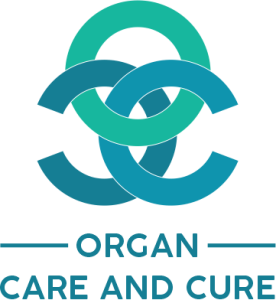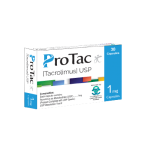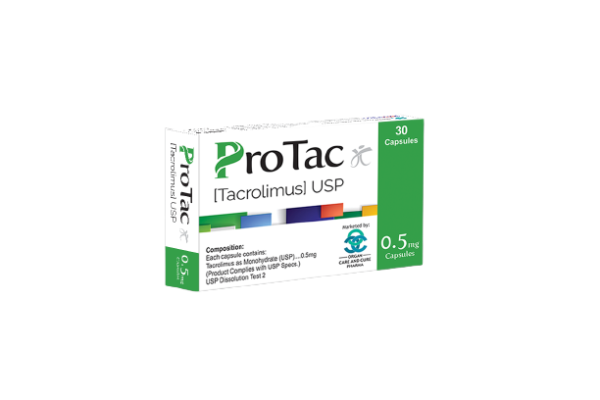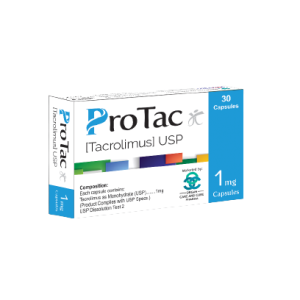Description
(Tacrolimus)
ProTac
0.5mg & 1 mg Capsules
Protecting the Precious Organs….
DESCRIPTION:
Inegral (tacrolimus) is available for oral administration as capsules containing the equivalent of 0.5 mg, 1 mg or 5 mg of anhydrous tacrolimus. Inactive ingredients include lactose, hydroxypropyl methylcellulose, croscarmellose sodium, and magnesium stearate.
CLINICAL PHARMACOLOGY:
Mechanism of Action Tacrolimus prolongs the survival of the host and transplanted graft in animal transplant models of liver kidney, heart, bone marrow, small bowel and pancreas, lung and trachea, skin, come, and limb. In animals, tacrolimus has been demonstrated to suppress some humorl immunity and, to a greater extent, cell-mediated reactions such as allograft rejection, delayed type hypersensitivity, collagen induced arthritis, experimental allergic encephalomyelitis, and graft versus host disease. Tacrolimus inhibits T-lymphocyte activation, although the exact mechanism of action is not known. Tacrolimus activity is primarily due to the parent drug.
Absorption:
Absorption of tacrolimus from the gastrointestinal tract after oral administration is incomplete and variable. The absolute bioavailability of tacrolimus was 17+b110% in adult kidney transplant patients (N=26), 22+b16% in adult liver transplant patients (N=17),23+’b19% in adult heart transplant patients (N=11) and 18+’b15% in healthy volunteers (N=16).emperature at the time of plasma separation, drug concentration, and plasma protein concentration. In a U.S. study, the ratio of whole blood concentration to plasma concentration averaged 35 (range 12 to 67).
Metabolism:
Tacrolimus is extensively metabolized by the mixed-function oxidas system, primarily the cytochrome P-450 system (CYP3A). A metabolic pathway leading to the formation of 8 possible metabolites has been proposed. Excretion: The mean clearance following IV administration of tacrolimus is 0,040, 0.083, and 0.053, and 0.051 L/hr/kg in healthy volunteers, adult kidney transplant patients, adult liver transplant patients and adult heart transplant patients, respectively. In man, less than 1% of the dose administered is excreted unchanged in urine.
INDICATIONS AND USAGE:
ProTac is indicated for the prophylaxis of organ rejection in patients receiving allogeneic liver, kidney or heart transplants. It is recommended that ProTac be used concomitantly with adrenal corticosteroids. Because of the risk of anaphylaxis, heart transplant recipients, it is recommended that ProTac be used in conjunction with azathioprine or mycophenolate mofetil (MMF).
CONTRAINDICATIONS:
ProTac is contraindicated in patients with a hypersensitivity to tacrolimus.
ADVERSE REACTIONS:
Use of ProTac with us in heart transplantation patients in a US study was associated with increased risk of renal function impairment, and is not recommended. More overt nephrotoxicity is seen early after transplantation, characterized by increasing serum creatinine and a decrease in urine output. Patients with impaired renal function should be monitored closely as the dosage of ProTac may need to be reduced. ProTac should not be used simultaneously with cyclosporinee. ProTac or cyclosporinee should be discontinued at least 24 hours prior to initiating the other. In the presence of elevated ProTac or cyclosporinee concentrations, dosing with the other drug usually should be further delayed. Mild to severe hyperkalemia was reported in 31% of kidney transplant recipients and in 45% and 13% of liver transplant recipients treated with ProTac in the U.S. and European randomized trials, respectively, and in 8% of heart transplant recipients in a European randomized trial and may require treatment. Neurotoxicity, Including tremor, headache and other changes in motor function.
Drug Interactions:
Due to the potential for additive or synergistic impairment of renal function, care should be taken when administering ProTac with drugs that may be associated with renal dysfunction. These include, but are not limited to, aminoglycosides, amphotericin B, and cisplatin. Initial clinical experience with the co-administration of ProTac and cyclosporine resulted in additive/synergistic nephrotoxicity.
Carcinogenesis, Mutagenesis and Impairment of Fertility:
An increased incidence of malignancy is a recognized complication of immunosuppression in recipients of organ transplants. The most common forms of neoplasms are non-Hodgkin’s Lymphomas and carcinomas of the skin.
Pregnancy Category C:
In reproduction studies in rats and rabbits, adverse effects on the fetus were observed mainly at dose levels that were toxic to dams. Tacrolimus at oral doses of 0.32 and 1.0 mg/kg during organogenesis in rabbits was associated with maternal toxicity as well as an increase in incidence of abortions; these doses are equivalent to 0.5-1X and 1.6-3.3X the recommended clinical dose range (0.1 -0.2 mg kg) based on body surface area corrections. At the higher dose only, an increased incidence of malformations and developmental variations was also seen. Nursing Mothers: Since tacrolimus is excreted in human milk, nursing should be avoided.
OVERDOSAGE:
Limited overdosage experience is available. Acute overdosages of up to 30 times the intended dose have been reported. Almost all cases have been asymptomatic and all patients recovered with no sequelae. Occasionally, acute overdosage has been followed by adverse reactions consistent with those listed in the adverse reactions.
Presentation:
ProTac 0.5mg capsules are available in Alu Alu pack of 30’s. ProTac 1mg capsules are available in Alu Alu pack of 30’s. ProTac 5mg capsules are available in Alu Alu pack of 10’s.
Full prescribing information available on request.
Composition:
Each capsule contains: Tacrolimus as Monohydrate (USP) fimg (Product Complies with USP Specs.) USP





Reviews
There are no reviews yet.